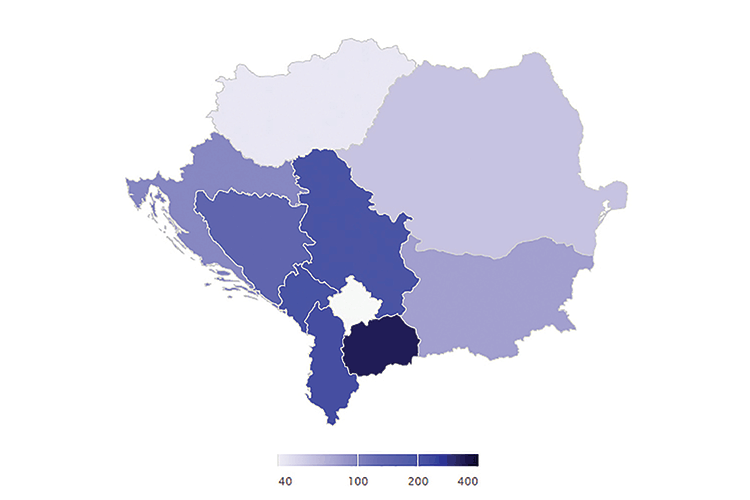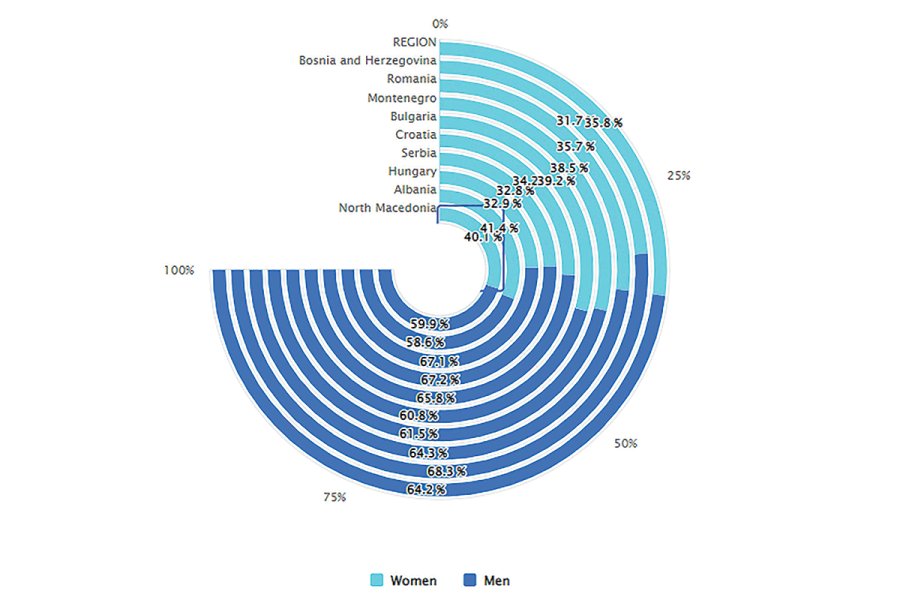The project Gigmeter aims to identify systemic characteristics of the gig work market in the region of Southeast Europe. This market includes Romania and Serbia, two countries that particularly distinguish themselves in global statistics with respect to the concentration and number of talents in the domain of gig work. North Macedonia, Montenegro and Bosnia and Herzegovina also stand out in relative terms (according to the gig workers/population ratio). In addition, Regional Gigmeter also includes Albania, Bulgaria, Croatia, and Hungary, forming a set of 9 countries where the trends and characteristics of gig work are being analysed
The leading global platforms in Southeast Europe in terms of the number of registered gig workers are Upwork, Freelancer, and Guru. In the latest measurement, 130,612 workers were registered in the observed 9 countries of the region.
In the distribution of gig work, the dominant regional position is still held by Upwork with a market share of 45%. Freelancers and Guru follow with 30.6% and 24.4%. Upwork continues to dominate and it is the most popular platform (in 7 out of 9 countries), but there is a significant change compared to the previous measurement when it was the most represented platform in all countries.
Largest increase in the number of gig workers per capita is recorded in Albania, while North Macedonia maintained the dominant position in the region according to this indicator (331 gig workers).
In the most recent measurement, Albania is the second country in the region in terms of the relative number of gig population thanks to the growth of this indicator by 22% – with 222 gig workers/100,000 inhabitants, which pushed Serbia to the third/fourth place, which has 208 gig workers/ 100,000 inhabitants, as much as Montenegro. Other countries in the region, with the exception of Bosnia and Herzegovina to some extent, have a much smaller population of gig workers.
In the latest measurement, there were certain changes when it comes to the distribution of workers by individual professions. In the two dominant areas – creative services and multimedia and software development, there was a further decline in the relative participation of gig workers, and a further decline in the share was recorded in the domain of professional services. On contrary, the most dynamic growth in most countries of the region was recorded in the field of writing and translation (4 out of 9 observed countries).

A decreasing trend in software development was recorded in the previous two measurements, which may have significant implications for the observed further relative decrease of the gig population in the most lucrative jobs, i.e. jobs that are the best paid on a global level. This may be a consequence of both the limited supply of this labor force in the observed region, as well as the trends in the domestic labor markets, where the demand, especially in the field of software development, is high.
The average employment of gig workers, which is defined as the percentage of gig workers who worked on specific projects at the time of measurement in relation to the total population, was 15.4%. Serbia, as in previous measurements, has the most active gig population (20.2%), while the lowest number of working people, was engaged in Albania – 9.4%. In other countries, the percentage of employment varies between 12.3% and 17.1%. The absolute differences between the countries are even more pronounced – according to the employment of the workforce, Serbia has a 5 times bigger number of gig workers working at the time of measurement than in Albania.
Out of 100 workers who were working at the time of measurement, 25 had the first job (first “gig”) they got. The countries with the highest share of workers who got a job for the first time are Albania (36 out of 100) and Hungary (32 out of 100). Serbia had only 20 gig workers for whom it was their first job out of a total of 100 workers who were working at the time of measurement.
The latest measurement brought a change in the trend when it comes to the gender structure of the digital labor market. There has been a decline in the share of female gig workers and now there are 358 women for every 1000 gig workers. The gender structure by country is presented in the Figure above.

Croatia is no longer the country with the most expensive workforce ($23.7/h), but Hungary ($23.8/h). This is the result of two factors: a smaller part due to the drop in the average labor price in Croatia and a larger part due to the increase in wages in Hungary. North Macedonia not only remained the country with the cheapest labor force in the region on average, but it is one of the 3 countries where the average hourly labor price has fallen (apart from the mentioned Croatia, this is also the case with Bulgaria). How big the differences are is best evidenced by the fact that a gig worker from Hungary works half a month to achieve the average monthly salary (measured according to the number of possible working hours in a regular employment relationship and the average price of gig work per hour in Hungary) earned by a gig worker from North Macedonia.
Convergence in earnings between men and women continued: on average, women in the region earned 85.3% of the average earnings of gig workers. According to this indicator, the region is significantly ahead of the global average: the global average is 82% globally according to the Payoneer survey, that is, only 52% according to the Bloomberg survey in the USA, country with the most developed digital labor market. While convergence in earnings is present at the regional level, differences appear at the level of individual countries. A more detailed analysis by countries is available in the latest edition of the Regional Gigmeter.
GigmetarTM is the first instrument that describes the geography of digital work in Serbia and the region in terms of gender, income, and most common occupations. It is a result of the efforts made by the Public Policy Research Centre (CENTAR) to shed the light on the work on online platforms.
Recommended citation: Anđelković, B., Jakobi, T., Ivanović, V., Kalinić, Z. & Radonjić, Lj. (2022). Gigmetar Region, October 2022, Public Policy Research Center, http://gigmetar. publicpolicy.rs/en/regionen- 2022-2/.